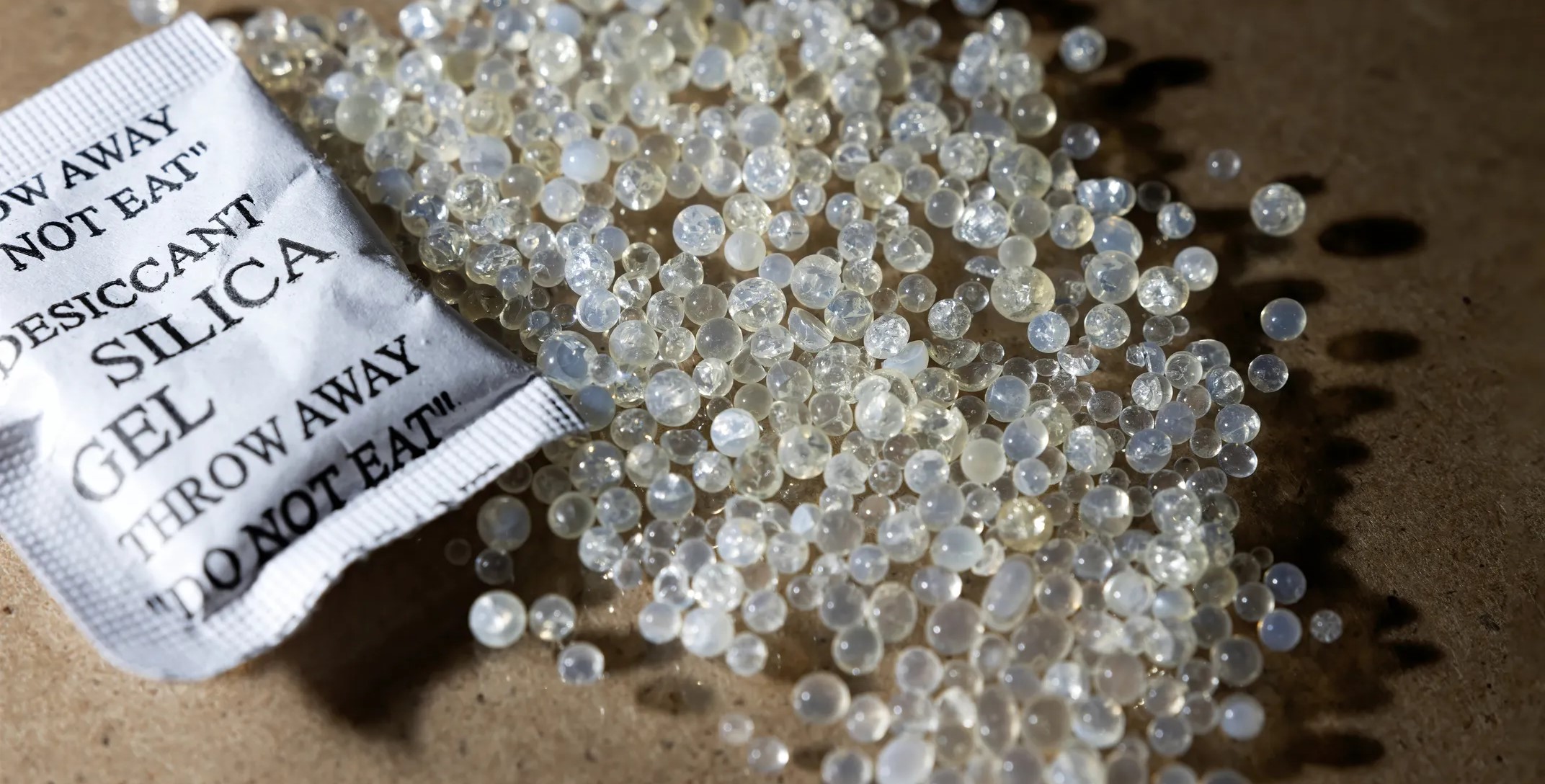Safety & Care
The Hidden Benefits of Silica Gel Packets: More than Just Moisture Absorption

Silica gel packets may seem like small, unassuming sachets found in the packaging of various products. You might have even dismissed them as nothing more than a nuisance to dispose of. But what if we told you that these tiny packets hold hidden benefits beyond just moisture absorption? That’s right! Silica gel packets are not only handy for keeping your belongings dry; they can also be incredibly versatile and useful in unexpected ways. In this blog post, we will delve into the lesser-known benefits of silica gel packets and explore how they can come to the rescue in various situations. So, get ready to discover the surprising wonders these little miracle workers have in store for you!
Rechargeable Paper Silica Gel Packets vs. Tyvek Packs
When it comes to silica gel packets, you may have come across two common types: rechargeable paper silica gel packets and Tyvek packs. Both serve the purpose of absorbing moisture, but they differ in a few key aspects.
Let’s talk about rechargeable paper silica gel packets. These packets are made from a special type of paper that can be recharged and used multiple times. Unlike single-use sachets, these reusable ones can save you money in the long run. All you need to do is place them in an oven at a low temperature for a specified time to remove the absorbed moisture and reactivate them. Voila! They’re ready to go again.
On the other hand, we have Tyvek packs—those sturdy little packages often found in electronic devices or pharmaceutical products. Made from high-density polyethylene fibers, Tyvek offers excellent durability and tear resistance. These packs are especially useful for protecting sensitive items like camera lenses or medications that require extra care during transportation or storage.
One advantage of rechargeable paper silica gel packets is their eco-friendliness compared to single-use alternatives like Tyvek packs. By investing in rechargeable options, you reduce waste generated by constantly discarding used sachets.
However, it’s worth noting that while both types perform well when it comes to moisture absorption, each has its limitations as well. Rechargeable paper silica gel packets may take longer to dry out after being saturated with moisture compared to Tyvek packs due to their absorbent properties.
Additionally, if your primary concern is preventing mold growth or musty odors caused by excess humidity within confined spaces such as closets or cabinets, either type will work effectively at keeping those pesky problems at bay.
Whether you choose rechargeable paper silica gel packets or opt for durable Tyvek packs depends on your specific needs and preferences. Consider factors such as cost-effectiveness, environmental impact, and the level of moisture absorption required for your intended use. With both options
Different Sizes of Silica Gel Packets and Their Uses
Silica gel packets are not a one-size-fits-all solution. In fact, these little moisture absorbers come in a variety of sizes to suit different needs and applications. Whether you’re storing shoes, electronics, or even food items, there’s a silica gel packet size that’s just right for the job.
The most common sizes of silica gel packets range from 1 gram all the way up to 100 grams. The smaller packets are perfect for placing inside shoeboxes or handbags to keep them dry and free from unpleasant odors caused by moisture buildup. They can also be used in camera cases or electronic devices to prevent condensation and protect delicate equipment.
For larger storage containers like toolboxes or closets, medium-sized silica gel packets ranging from 10 grams to 30 grams are ideal. These packs have a higher absorption capacity and can effectively tackle dampness in enclosed spaces. They’re also great for keeping important documents safe from mold or mildew damage.
When it comes to bulkier items such as clothing boxes, sports equipment bags, or even safes – where moisture is more likely to accumulate – it’s recommended to use large-sized silica gel packets ranging from 50 grams up to 100 grams. These powerful packs have high absorption rates and can help maintain optimal humidity levels over an extended period.
Additionally, there are specialty sizes available with specific uses in mind. For instance, mini silica gel packets weighing around half a gram are often used for medications or vitamin bottles that need extra protection against moisture exposure.
No matter what size you choose, it’s crucial to remember that proper placement is key for maximum effectiveness. Make sure the packets are evenly distributed throughout the container or space being protected so they can efficiently absorb any excess moisture present.
In conclusion (as per your instructions), having different sizes of silica gel packets allows users flexibility when combating humidity-related issues across various scenarios – big or small! So whether you want safeguard your favorite leather shoes or preserve important documents, there’s a silica gel packet size
Exploring the Lesser-Known Benefits of Silica Gel Packets
Silica gel packets are commonly known for their ability to absorb moisture and keep our belongings dry. But did you know that these little packets have even more benefits than just preventing dampness? In this blog post, we will explore some of the lesser-known advantages of silica gel packets.
1. Odor Control: Silica gel is not only effective at absorbing moisture, but it also has the ability to reduce unpleasant odors. Whether it’s inside your gym bag, shoe cabinet, or closet, placing a few silica gel packets can help eliminate unwanted smells and keep your surroundings fresh.
2. Preservation of Documents: Important documents such as passports, birth certificates, and photos are susceptible to damage from humidity. By storing them with silica gel packets in an airtight container or file folder, you can protect them from moisture-induced deterioration and preserve them for longer periods.
3. Prolonging the Lifespan of Electronics: Electronic devices like cameras, smartphones, and laptops can be negatively affected by excess humidity. By placing silica gel packets near these gadgets when they’re not in use or inside protective cases during transportation or storage, you can help extend their lifespan by preventing moisture-related issues like corrosion.
4. Preventing Silver Tarnish: Silver jewelry and silverware tend to tarnish over time due to exposure to air and humidity. Placing a few silica gel packets along with your silver items helps absorb excess moisture in the storage area and minimize tarnishing effects on your precious valuables.
5. Protecting Collectibles: If you’re an avid collector of stamps, coins, or vintage items prone to mold growth or degradation caused by humidity fluctuations; using silica gel packs can provide added protection against these environmental factors that could potentially damage your collection over time.
6. Extending Food Shelf Life: Silica gel is commonly used in food packaging. Because it helps maintain freshness by controlling moisture levels that promote bacterial growth or spoilage. You can also place silica gel packets in containers holding dried herbs, spices,
How to Properly Use and Store Silica Gel Packets
Silica gel packets are not only useful for absorbing moisture. But they can also be incredibly effective in preserving the quality of various items. However, to make the most out of these small yet powerful desiccants, it’s important to know how to properly use, And store them. Here are some tips on getting the best results from your silica gel packet’s.
It’s essential to understand that silica gel is a drying agent and should never be ingested. Keep these packets away from children and pets at all times. If accidentally consumed, seek medical help immediately.
When using silica gel packets for moisture control purposes, ensure. That you use enough packs for the given space or item size. The general rule of thumb is one packet per cubic foot of enclosed area. However, this may vary depending on the humidity levels in your region.
To maximize their effectiveness, avoid puncturing or tearing open the packets. The sealed packaging ensures that the silica gel remains dry until needed. Once opened, they will start absorbing moisture from their surroundings.
Make sure to place the silicone gel packs close to items prone to damage by moisture such as electronics, leather goods, or documents. You can include them inside storage containers or ziplock bags along with those valuable possessions you want to protect.
Proper storage is crucial when it comes to maintaining the integrity of silica gel packet’s over time. To ensure their longevity and reusability (if applicable), keep them in airtight containers when not in use. This prevents exposure to excess humidity which could render them less effective before intended usage.
Lastly,
remember that even though some types of silica gels can be recharged by heating them in an oven according
to manufacturer’s instructions,
it’s always wise
to periodically replace used-up packs with fresh ones.
By following these simple guidelines,
you’ll get optimal performance from your silica gel packet’s while keeping your belongings safe from moisture-related damage.
Customer Reviews and Experiences with Silica Gel Packets
One of the best ways to gauge the effectiveness and usefulness of a product is by hearing from those who have actually used it. When it comes to silica gel packets, customers have had some interesting experiences and positive reviews.
Many customers rave about how silica gel packet’s have helped them preserve their valuables. Whether it’s protecting important documents, electronics, or even cherished keepsakes. People appreciate the peace of mind that comes with knowing moisture won’t damage their belongings. Some reviewers even mention using silica gel packet’s in storage containers for clothing and shoes to prevent musty odors.
Another common theme in customer reviews is how long-lasting and versatile these little packs can be. People are pleasantly surprised by how often they can reuse them after recharging. With rechargeable paper silica gel packet’s or tyvek packs, you can simply place them in an oven for a short time. At a low temperature to restore their moisture-absorbing abilities.
Customers also appreciate the variety of sizes available when purchasing silica gel packet’s. From tiny sachets perfect for shoeboxes or camera cases to larger ones suitable for closets or toolboxes, there’s a size that fits every need.
Many users find additional benefits beyond moisture absorption when using silica gel packet’s. Some individuals claim that placing these packs in food storage. Containers helps keep items fresher for longer periods by reducing humidity levels inside. Others note that placing them near gym bags or sweaty workout gear helps eliminate unpleasant odors.
It’s clear that silica gel packets offer more than just moisture absorption capabilities. They provide peace of mind, versatility, longevity, and various other benefits depending on your needs. So next time you come across one of these small but mighty packs don’t underestimate its potential -embrace its hidden powers.
Safety & Care
Mixing 5W-20 and 5W-30: Is It Safe for Your Engine?

Introduction
Engine oil plays a critical role in keeping your vehicle running smoothly. It’s designed to lubricate engine components, reduce friction, and protect against wear and tear. Among the many options available, 5W-20 and 5W-30 are popular choices, each with its own set of benefits. But what if you find yourself with both types on hand? Is it safe to mix 5W-20 and 5W-30? In this article, we’ll delve into the implications of mixing these two oils and what it means for your engine’s health.
Understanding Engine Oil Viscosity
What Does 5W-20 and 5W-30 Mean?
The numbers in oil grades like 5W-20 and 5W-30 indicate the oil’s viscosity, or thickness, at different temperatures. The “5W” stands for the oil’s viscosity in winter (low temperatures), while the “20” or “30” represents its viscosity at high temperatures.
- 5W-20: This oil has a lower viscosity when cold, making it easier to flow in colder conditions. It is often recommended for newer engines for better fuel efficiency.
- 5W-30: This oil has a higher viscosity at operating temperatures, providing better protection in warmer conditions and high-stress situations.
The Role of Viscosity in Engine Performance

Viscosity affects how well oil flows through your engine. Proper viscosity ensures that the oil effectively lubricates engine parts, reduces friction, and prevents overheating.
- Lower Viscosity Oils: These flow more easily at startup and in cold conditions, but might be less effective under high heat.
- Higher Viscosity Oils: Provide better protection at high temperatures but can be thicker at startup.
How Oil Viscosity Affects Engine Longevity
Using the right viscosity for your engine ensures optimal performance and longevity. Using oil with inappropriate viscosity can lead to insufficient lubrication, increased wear, and potential engine damage over time.
Can You Mix 5W-20 and 5W-30?
Common Reasons for Mixing Oils
Drivers might mix oils for various reasons, such as running low on one type, or having different types of oil available. However, this practice can raise questions about safety and effectiveness.
Technical Feasibility of Mixing Different Viscosities
Technically, mixing 5W-20 with 5W-30 is possible because both are compatible with each other. The combined viscosity will fall somewhere between the two, but this can vary depending on the proportions mixed.
Manufacturer Recommendations and Warnings
Most vehicle manufacturers recommend using a specific oil grade for optimal performance. Mixing different grades might not align with these recommendations and could affect the oil’s performance. Always check your vehicle’s manual for the manufacturer’s guidance.
Pros and Cons of Mixing 5W-20 and 5W-30
Potential Benefits
- Flexibility: Mixing can be a temporary solution if you’re in a pinch and need to top off your oil.
- Cost Efficiency: It might be cost-effective in the short term if you already have both types of oil.
Possible Drawbacks and Risks
- Compromised Performance: The mixed oil might not offer the best protection or efficiency.
- Increased Wear: Long-term use of mixed oils could lead to increased engine wear and reduced efficiency.
Impact on Engine Performance
How Mixing Affects Lubrication
Mixing oils alters the viscosity and can impact how effectively the oil lubricates the engine. This might lead to reduced protection, especially under extreme conditions.
Potential Effects on Engine Efficiency
The efficiency of the engine could be compromised if the mixed oil does not perform as intended, potentially affecting fuel economy and overall performance.
Long-Term Consequences for Engine Health
Regular use of mixed oils might result in long-term damage or reduced engine longevity. It’s best to use the recommended oil type to ensure optimal engine health.
Best Practices for Oil Maintenance
Choosing the Right Oil for Your Engine
Always use the oil grade recommended by your vehicle’s manufacturer. This ensures optimal performance and protection for your engine.
Regular Oil Changes and Maintenance Tips
Regularly changing your oil as recommended helps maintain engine performance and longevity. Follow your vehicle’s maintenance schedule for oil changes.
Monitoring Oil Levels and Quality
Regularly check your oil level and quality. Low or dirty oil can affect engine performance and lead to potential damage.
Alternatives to Mixing Oils
Using Single-Grade Oils
Using a single grade oil as specified by your manufacturer is the best practice for engine health and performance.
Synthetic vs. Conventional Oils
- Synthetic Oils: Offer better performance and protection, especially under extreme conditions.
- Conventional Oils: More affordable but may not provide the same level of protection.
Recommended Oil Types for Different Engines
Consult your vehicle’s manual for the best oil type and grade for your engine. Different engines have different requirements based on their design and performance needs.
What to Do if You’ve Mixed Oils
Steps to Take if You’ve Mixed 5W-20 and 5W-30
If you’ve mixed oils, it’s generally recommended to replace the oil with the correct grade as soon as possible.
When to Seek Professional Advice
If you’re unsure about the impact of mixing oils or need guidance on oil replacement, consult a professional mechanic.
How to Flush and Replace Engine Oil
Flushing the engine and replacing the oil with the recommended grade ensures optimal performance and protection. Follow proper procedures or seek professional help.
Conclusion
Mixing 5W-20 and 5W-30 oils might seem like a convenient solution, but it can compromise your engine’s performance and longevity. The best practice is to use the oil grade recommended by your vehicle’s manufacturer and adhere to regular maintenance schedules. Ensuring you use the correct oil type helps maintain engine efficiency and longevity.
FAQs
What happens if you mix 5W-20 and 5W-30 oil?
Mixing these oils creates a blend with intermediate viscosity, which may not provide optimal performance or protection.
Can mixing these oils damage your engine?
Long-term use of mixed oils can potentially cause increased wear and reduce engine efficiency.
How often should you change your engine oil?
Follow your vehicle’s manufacturer recommendations, typically every 3,000 to 7,500 miles or as specified.
Is synthetic oil better than conventional oil?
Synthetic oil generally offers better performance and protection, especially under extreme conditions, compared to conventional oil.
What should you do if you accidentally mix different oil viscosities?
Replace the mixed oil with the recommended grade as soon as possible to maintain optimal engine performance and protection.
Safety & Care
Border Collies and Water: A Natural Affinity

Introduction
Border Collies, renowned for their intelligence and agility, are a breed that excels in a variety of activities. While their herding skills are well-documented, many may not realize that Border Collies also have a natural affinity for water. This article delves into the fascinating relationship between Border Collies and water, exploring their history, traits, and the benefits of water activities for these energetic dogs.

History of Border Collies
Border Collies originated along the border of Scotland and England, bred specifically for their herding abilities. These dogs were developed to manage flocks of sheep over rough terrain, making them indispensable to shepherds. Over time, their intelligence and agility became key characteristics, allowing them to excel in various roles beyond herding.
Physical Traits of Border Collies
Border Collies are known for their lean and athletic build, which contributes to their incredible agility. Their double coat, consisting of a dense undercoat and a rough outer coat, provides some resistance to water, helping them stay comfortable during water activities. This coat also helps protect them from harsh weather conditions, whether they are herding sheep or swimming in a lake.
Behavioral Traits
One of the most notable traits of Border Collies is their intelligence. Ranked among the smartest dog breeds, they are highly trainable and responsive to commands. This intelligence, combined with their natural herding instincts, makes them keen problem solvers and quick learners. These traits also contribute to their enthusiasm for water activities, as they are always eager to explore and engage in new experiences.
Why Border Collies Love Water
Border Collies’ love for water can be attributed to their natural instincts and curiosity. Water offers a new environment for them to explore, and their high energy levels make swimming and playing in water ideal activities. Additionally, water activities provide a great way for them to cool off, especially during hot weather.
Swimming and Border Collies
Introducing your Border Collie to swimming can be a rewarding experience. Start in shallow water, allowing them to get used to the sensation of being wet. Gradually encourage them to venture deeper, using toys or treats as incentives. Many Border Collies take to swimming naturally, but patience and positive reinforcement are key.
Safety Tips for Border Collies in Water
While Border Collies may enjoy water, safety should always be a priority. Monitor them closely for signs of fatigue, and ensure they have a life vest, especially in deeper waters. It’s also important to provide them with regular breaks and fresh water to prevent dehydration.
Activities Involving Water
Water opens up a range of fun activities for Border Collies. Fetch and retrieval games can be enhanced by playing in water, offering both physical exercise and mental stimulation. Dock diving is another popular activity, where Border Collies can showcase their agility and jumping skills in a competitive setting.
Border Collies and Water Herding
Interestingly, some Border Collies have been known to herd in water. This unique practice involves guiding flocks through streams or ponds, showcasing their versatility and herding prowess. Historical anecdotes highlight the remarkable ability of these dogs to adapt their herding techniques to various environments.
Training Border Collies for Water Activities
Training your Border Collie for water activities requires a step-by-step approach. Start with basic commands on land, then gradually introduce them to water. Use positive reinforcement, such as treats and praise, to build their confidence. Consistency and patience are essential for successful training.
Benefits of Water Activities for Border Collies
Water activities offer numerous benefits for Border Collies. Physically, swimming is an excellent form of exercise that builds strength and endurance without putting stress on their joints. Mentally, water activities provide stimulation and an opportunity to engage their problem-solving skills.
Challenges with Border Collies and Water
Despite their natural affinity, some Border Collies may face challenges with water. Fear or anxiety can be common, but these can often be overcome with gradual exposure and positive experiences. Preventing overexertion is also crucial, as Border Collies can sometimes be too enthusiastic for their own good.
Health Considerations
Regular health checks are important for Border Collies, especially if they frequently engage in water activities. Ear infections are a common issue due to moisture, so proper ear care is essential. Always ensure your Border Collie is up-to-date with vaccinations and parasite prevention.
Border Collies’ Water Adventures
Many Border Collie owners have fascinating stories of their dogs’ water adventures. From epic beach runs to impressive dock diving feats, these stories highlight the breed’s love for water. Some B’order Collies have even gained fame for their water skills, becoming stars in dog sports and competitions.
Conclusion
Border Collies and water share a natural affinity that can be incredibly rewarding for both the dog and the owner. With their intelligence, agility, and enthusiasm, B’order Collies are well-suited for a variety of water activities. By understanding their traits and taking appropriate precautions, you can ensure a safe and enjoyable experience for your furry friend.
FAQs
How can I get my B’order Collie to enjoy water?
Start by introducing them to shallow water and use toys or treats to make the experience positive. Gradually increase their exposure and always use positive reinforcement.
Are B’order Collies natural swimmers?
Many B’order Collies are natural swimmers, but not all. Patience and training are key to helping them become comfortable in water.
What water activities are best for B’order Collies?
Fetch games, dock diving, and swimming are great water activities for B’order Collies. They provide both physical exercise and mental stimulation.
How often should my Border Collie swim?
This depends on your dog’s health and fitness level, but generally, a few times a week is beneficial. Always monitor for signs of fatigue and provide breaks.
What precautions should I take when my Border Collie is in water?
Ensure they wear a life vest in deep water, monitor for fatigue, provide fresh water to drink, and practice proper ear care to prevent infections.
Safety & Care
Clindanol: The Ultimate Guide to Clear Skin

In the quest for flawless skin, many individuals turn to various skincare products to address concerns such as acne, blemishes, and uneven texture. One such solution that has garnered attention in recent years is Clindanol. In this comprehensive guide, we will delve into the intricacies of Clindanol, exploring its benefits, usage, and effectiveness in achieving radiant, clear skin.
Understanding Clindanol
What is Clindanol?
Clindanol is a topical medication primarily used to treat acne vulgaris, a common skin condition characterized by the presence of pimples, blackheads, and whiteheads. It belongs to a class of medications known as topical antibiotics, which work by inhibiting the growth of acne-causing bacteria on the skin’s surface.
How Does Clindanol Work?
Clindano’l contains the active ingredient clindamycin, which exhibits antibacterial properties. When applied to the skin, Clindanol penetrates the pores and targets the bacteria responsible for acne. By reducing bacterial growth and inflammation, it helps alleviate existing acne lesions and prevents new ones from forming.
Benefits of Clindanol
Effective Acne Treatment
One of the primary benefits of Clindano’l is its effectiveness in treating acne. Clinical studies have demonstrated its ability to significantly reduce the number of acne lesions and improve overall skin clarity.
Minimizes Inflammation
In addition to combating acne-causing bacteria, Clindano’l also helps minimize inflammation associated with acne. This can lead to faster healing of existing blemishes and a reduction in redness and swelling.
Suitable for Various Skin Types
Clindano’l is formulated to be gentle on the skin, making it suitable for individuals with sensitive skin or those prone to irritation from other acne treatments. Its non-comedogenic formula means it won’t clog pores, making it suitable for use on oily or acne-prone skin.
How to Use Clindanol
Application Instructions
To use Clindanol effectively, follow these steps:
- Cleanse the skin thoroughly and pat dry.
- Apply a thin layer of Clindanol gel or lotion to the affected areas.
- Allow the medication to absorb fully before applying any additional skincare products.
- Use Clindanol as directed by your healthcare provider, typically once or twice daily.
Tips for Optimal Results
- Consistency is key when using Clindano’l . Stick to a regular skincare routine to maximize its effectiveness.
- Avoid applying Clindano’l to broken or irritated skin, as it may cause further irritation.
- Use sunscreen daily, as Clindano’l may increase sensitivity to sunlight.
Conclusion
Clindano’l offers a promising solution for individuals struggling with acne. Its potent antibacterial properties, combined with its gentle formulation, make it a popular choice among dermatologists and patients alike. By incorporating Clindanol into your skincare routine and following proper application techniques, you can achieve clearer, healthier-looking skin.
FAQs
1. Is Clindano’l suitable for all types of acne?
While Clindano’l is effective for many individuals with acne vulgaris, it may not be suitable for severe or cystic acne. Consult with a dermatologist to determine the best treatment plan for your specific condition.
2. Can I use Clindano’l with other acne treatments?
Clindano’l can be used in conjunction with other acne treatments, such as benzoyl peroxide or salicylic acid. However, it’s essential to follow your healthcare provider’s recommendations and avoid overusing multiple products, as this can lead to irritation.
3. How long does it take to see results with Clindano’l?
Individual results may vary, but many users report seeing improvement in their acne within a few weeks of starting Clindanol treatment. Consistent use is key to achieving optimal results.
4. Are there any side effects associated with Clindano’l?
Common side effects of Clindanol may include dryness, peeling, or redness at the application site. If you experience severe irritation or allergic reactions, discontinue use and consult a healthcare professional.
5. Can Clindano’l be used for long-term acne maintenance?
Clindano’l is generally safe for long-term use, but it’s essential to monitor your skin’s response and adjust your treatment plan as needed. Regular follow-up appointments with a dermatologist can help ensure the continued effectiveness and safety of Clindanol therapy
-

 Fashion2 years ago
Fashion2 years agoExploring Purenudism: Embracing Body Positivity and Freedom
-

 Shops1 year ago
Shops1 year agoStaples Store Hours: What Time Does Staples Open And Close?
-

 Shops2 years ago
Shops2 years agoWalmart Vision Center Hours
-

 Shops1 year ago
Shops1 year agoWalgreen Pharmacy Hours: What Time Does It Open & Close?
-

 Shops1 year ago
Shops1 year agoPublix Pharmacy Hours and Locations
-

 Entertainment2 years ago
Entertainment2 years agoThothub.lol: The Digital Realm of Entertainment
-

 Business2 years ago
Business2 years agoDesigner Clothing: Making a Statement
-

 Shops1 year ago
Shops1 year agoWalmart Deli Open & Close Hours
